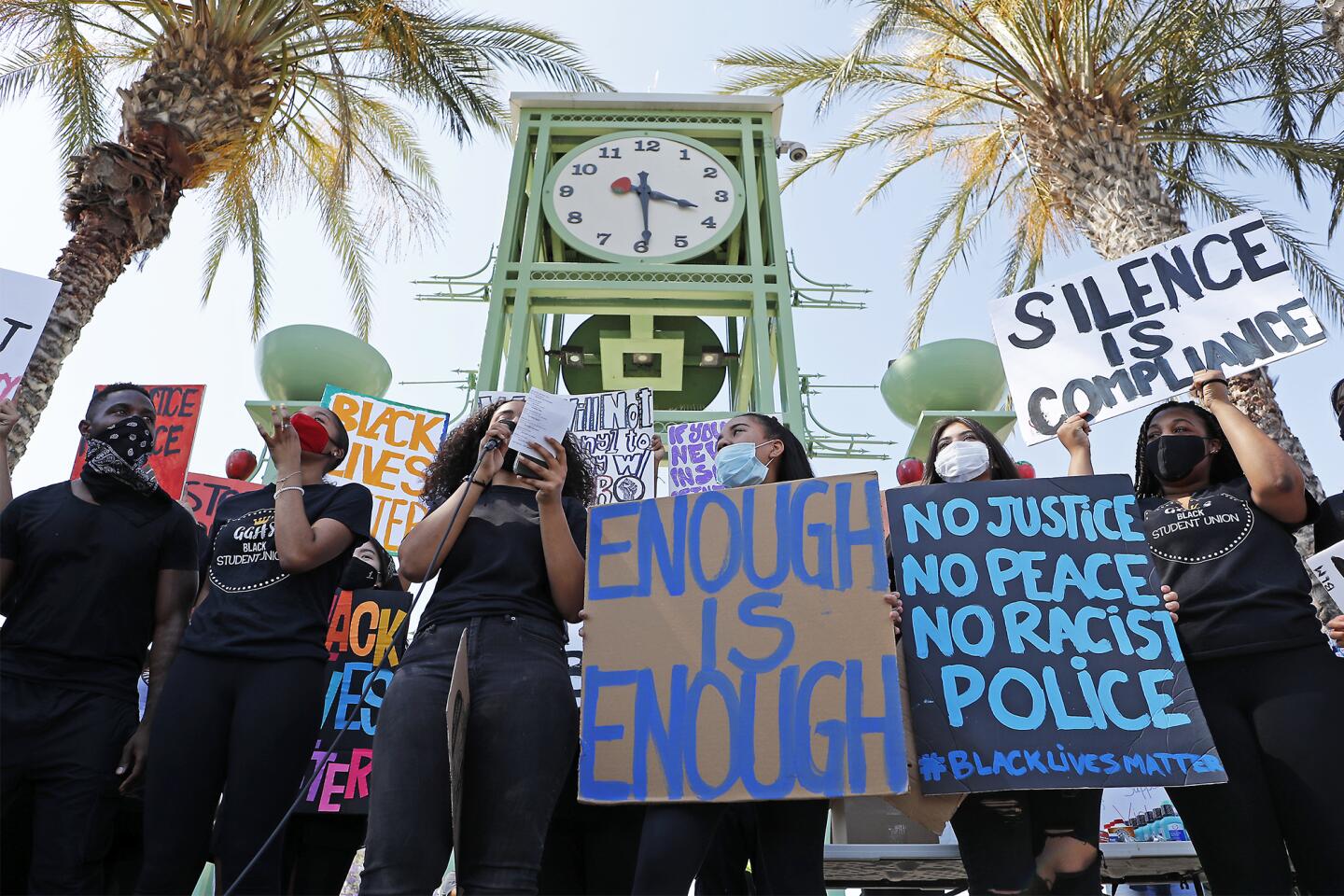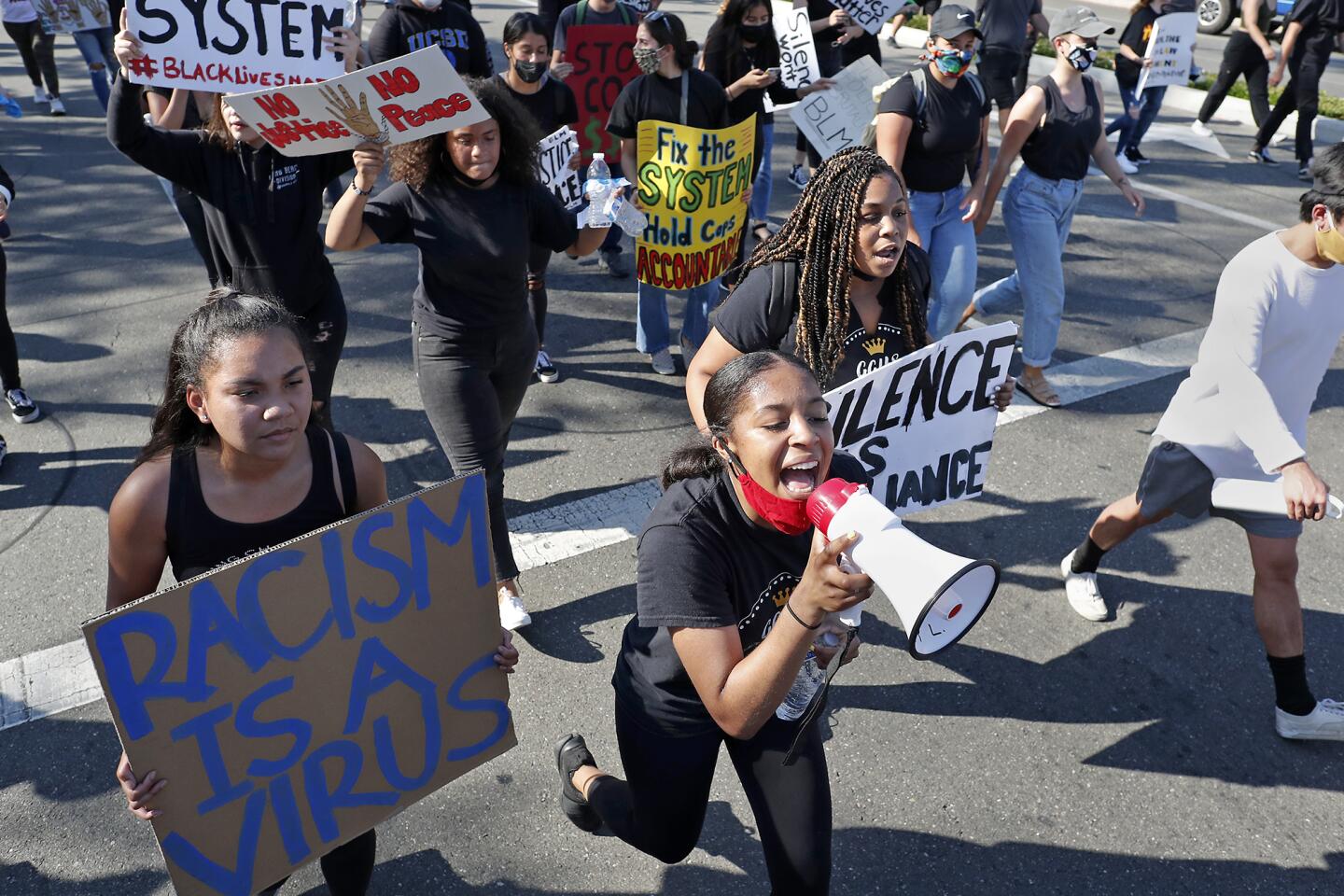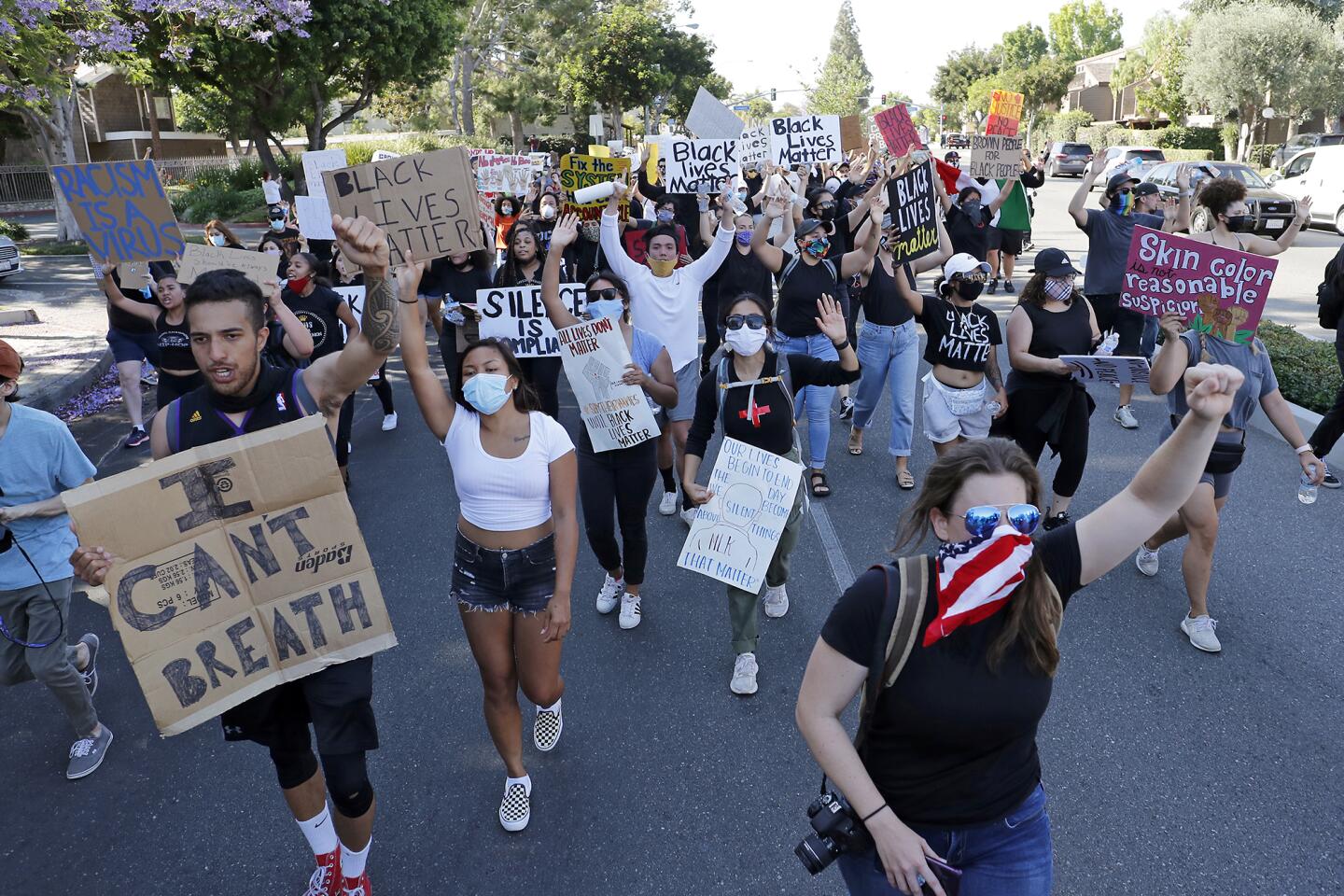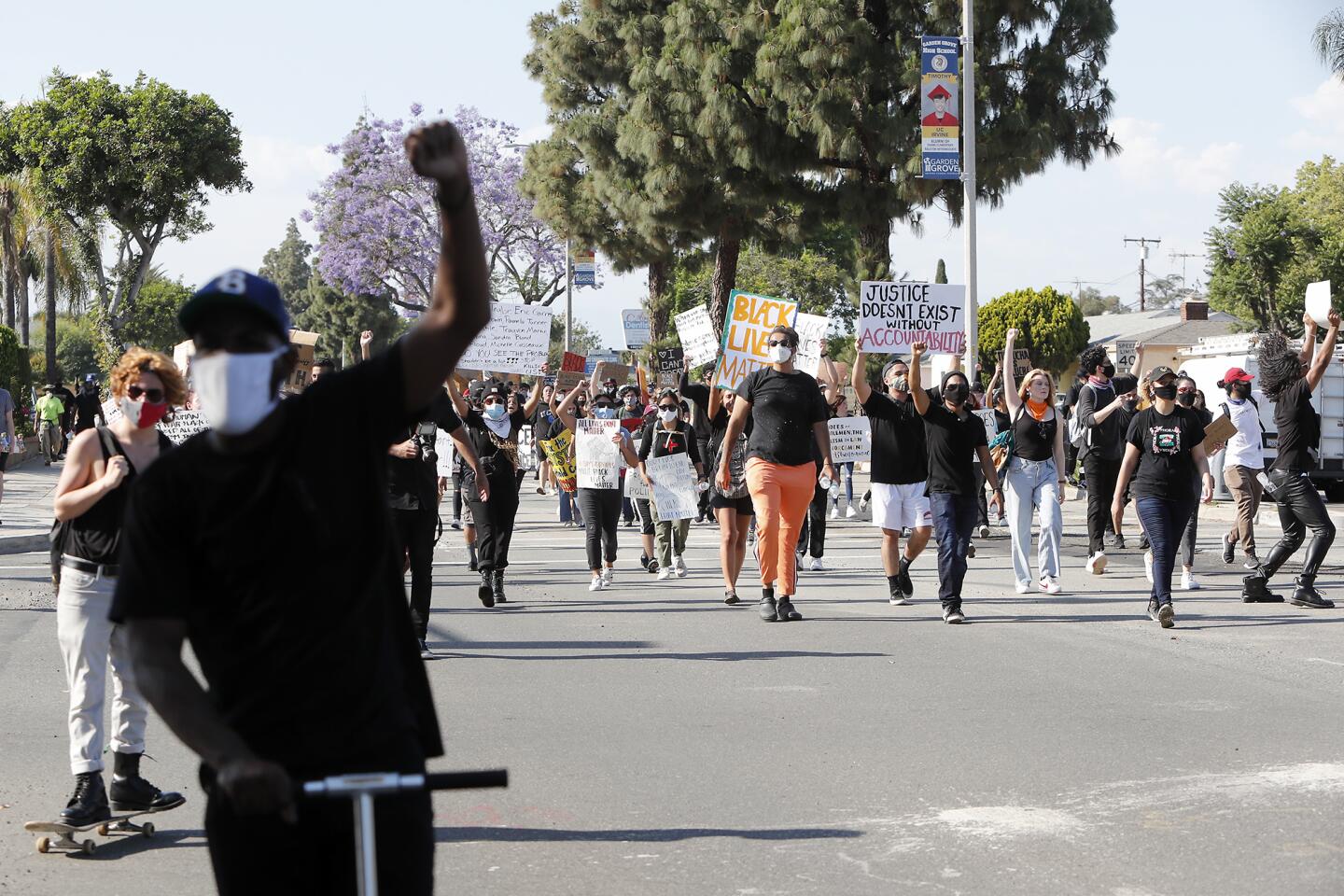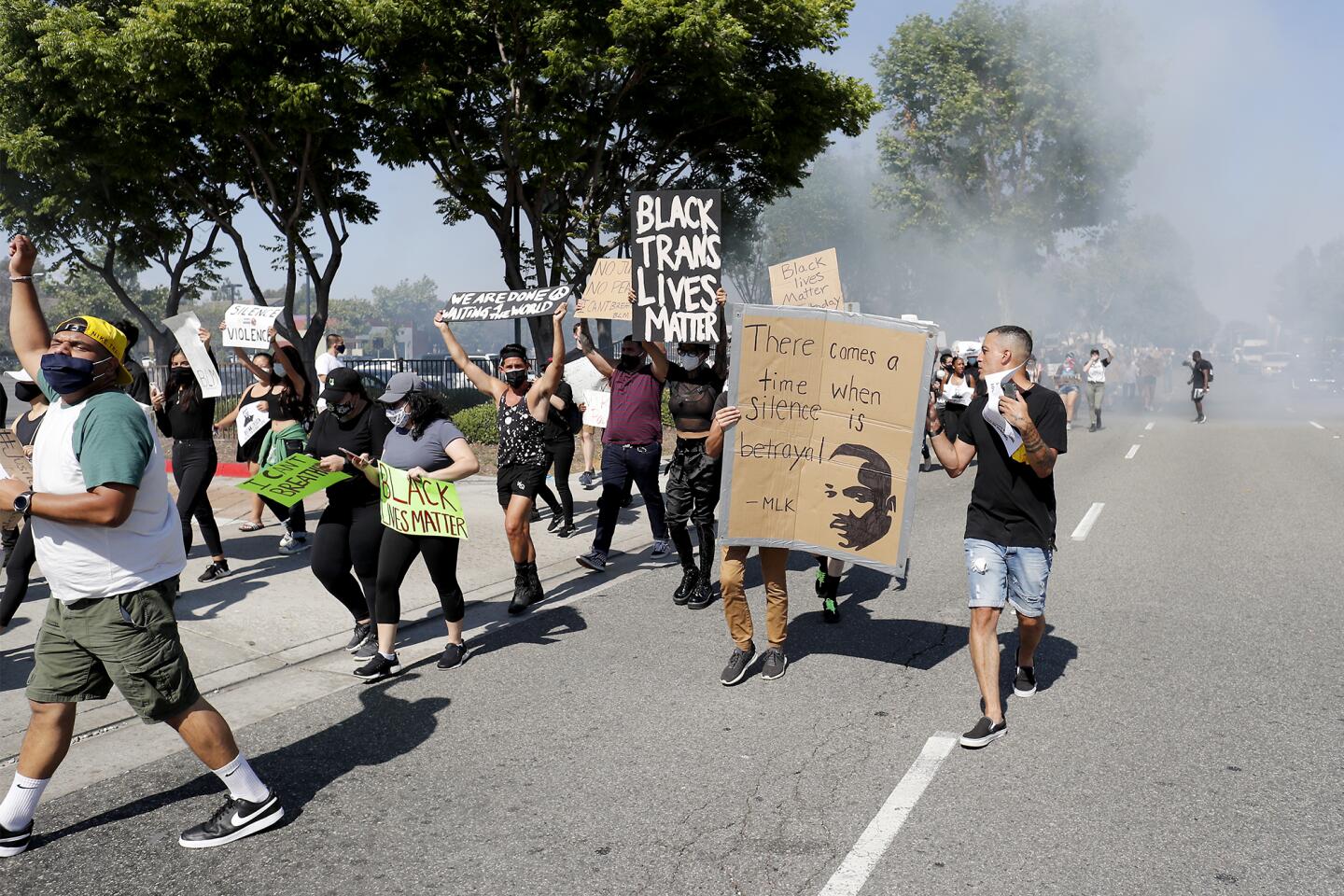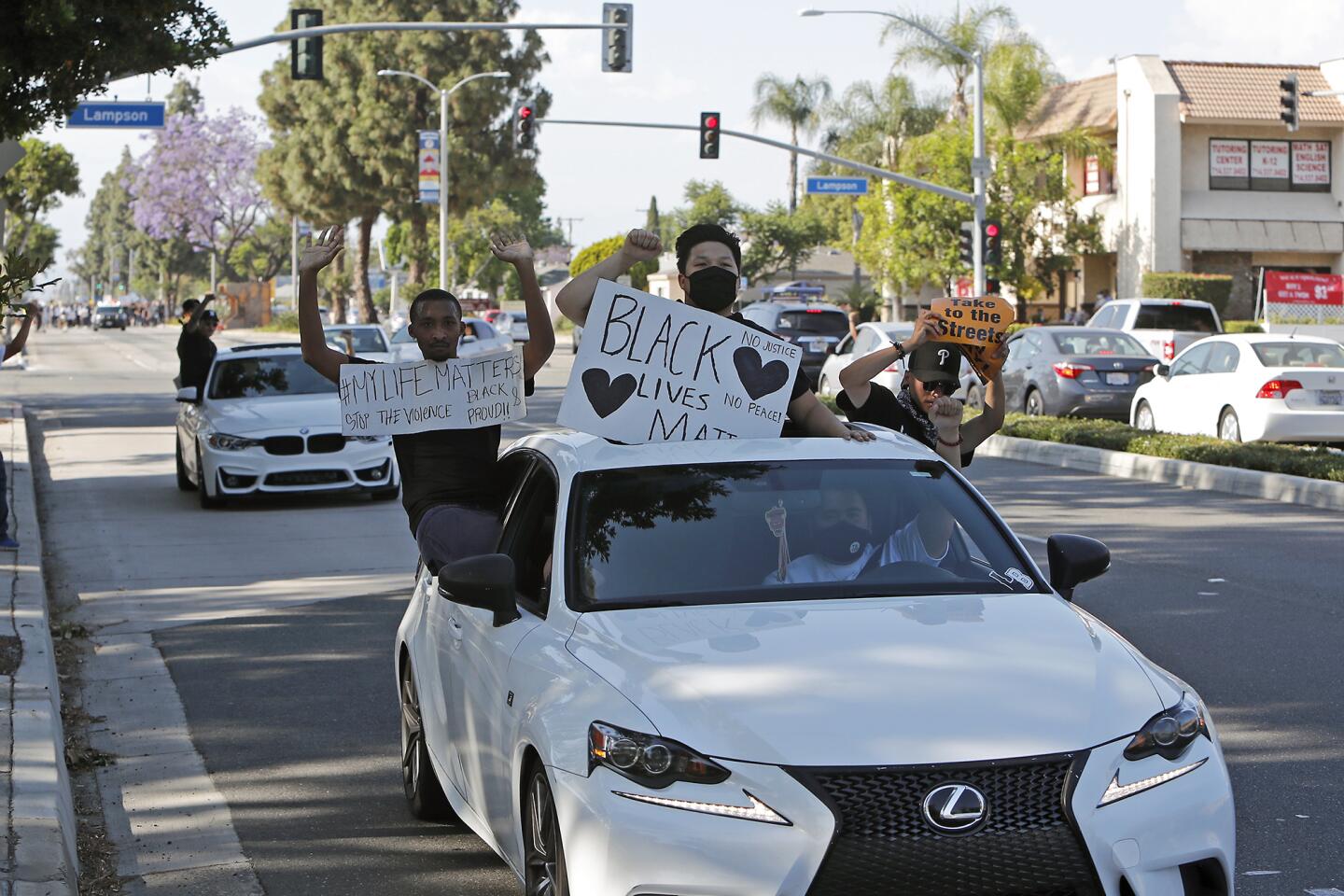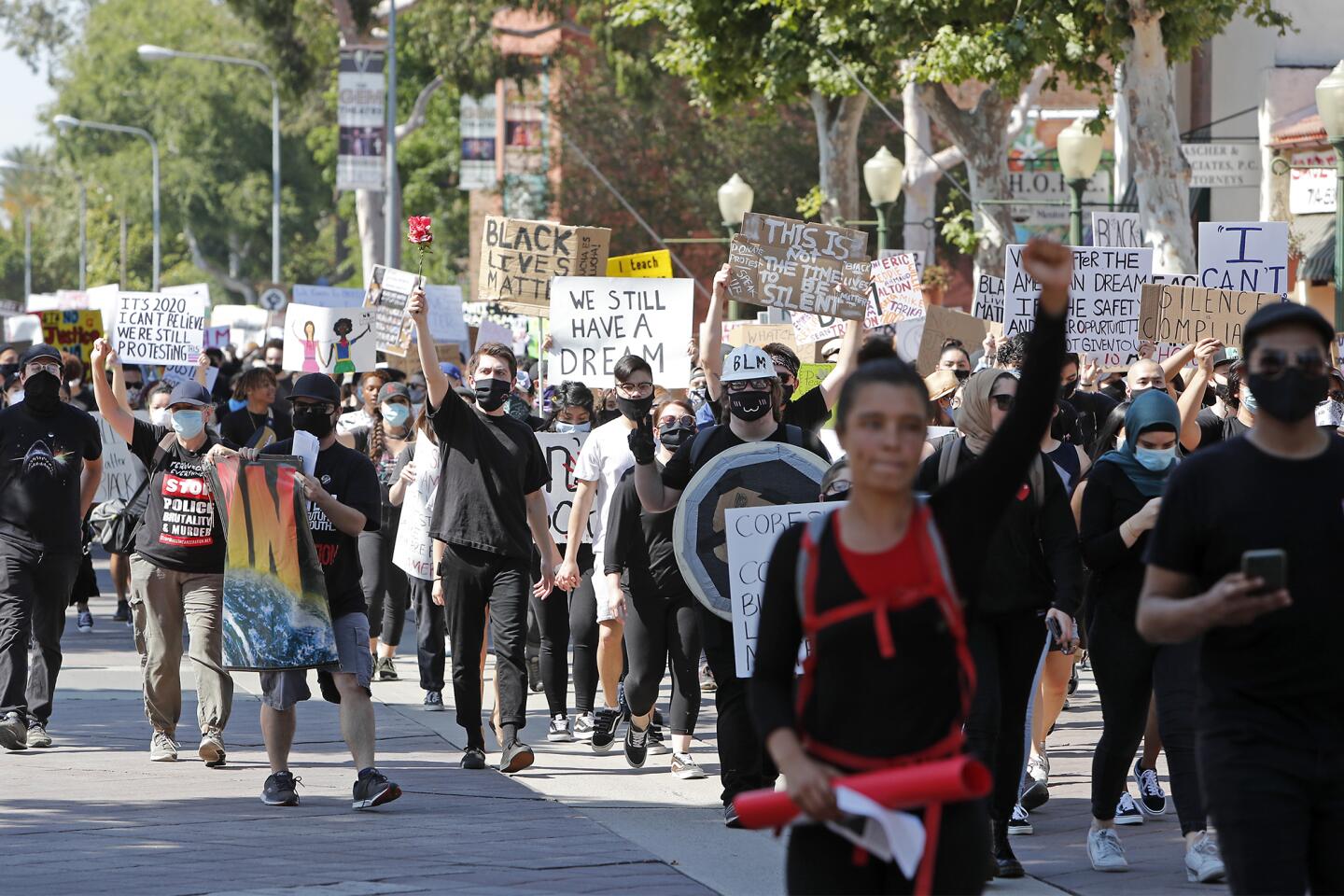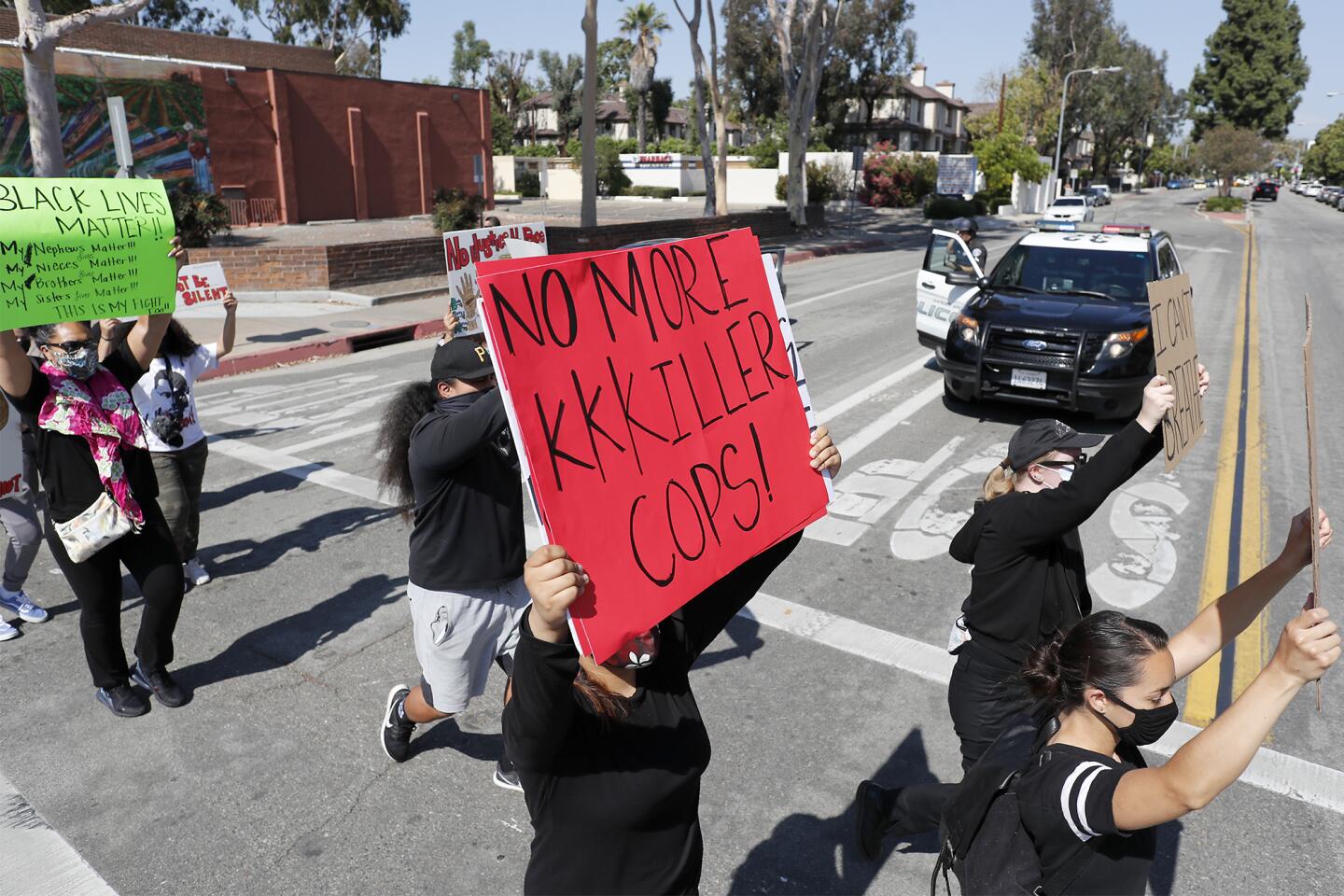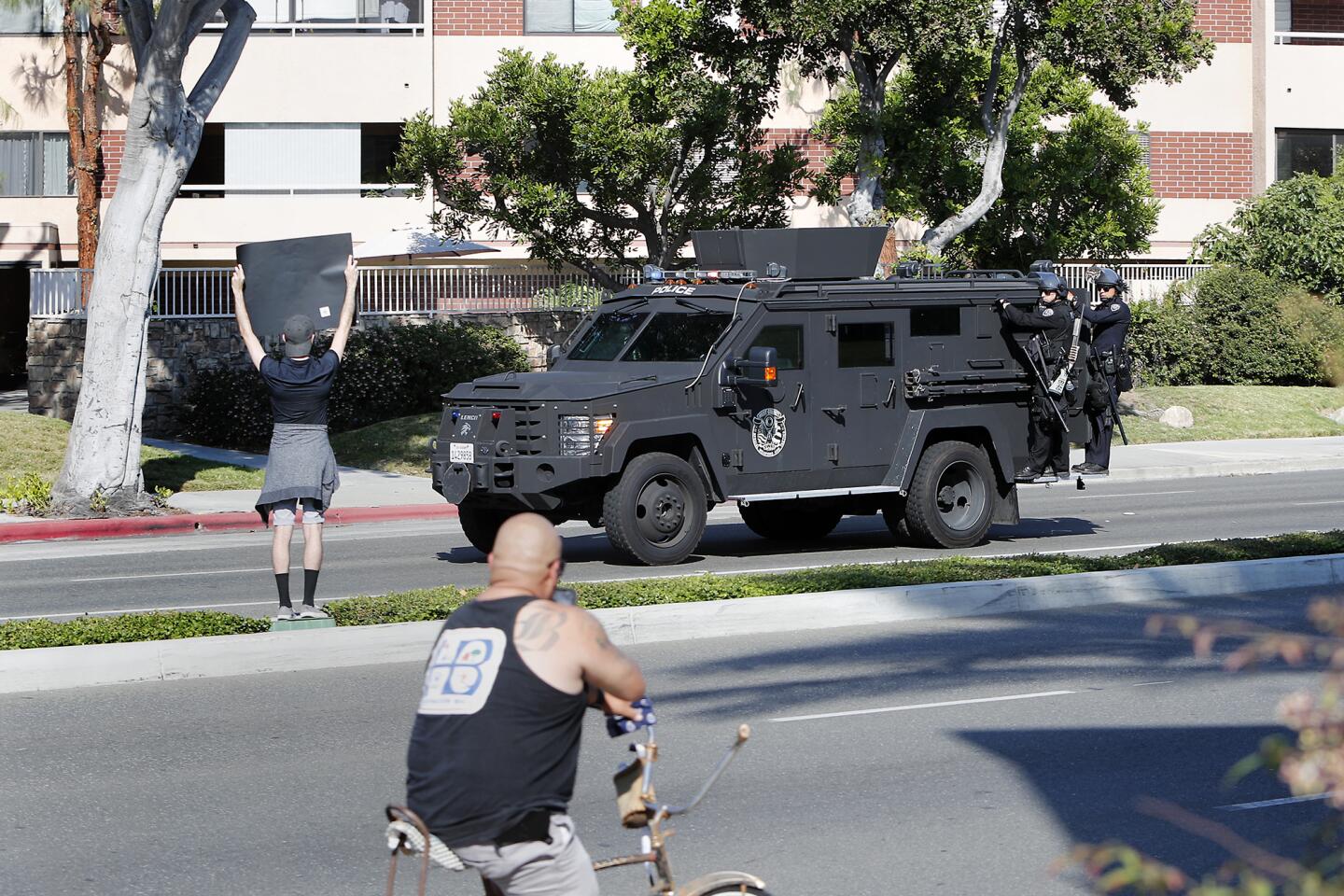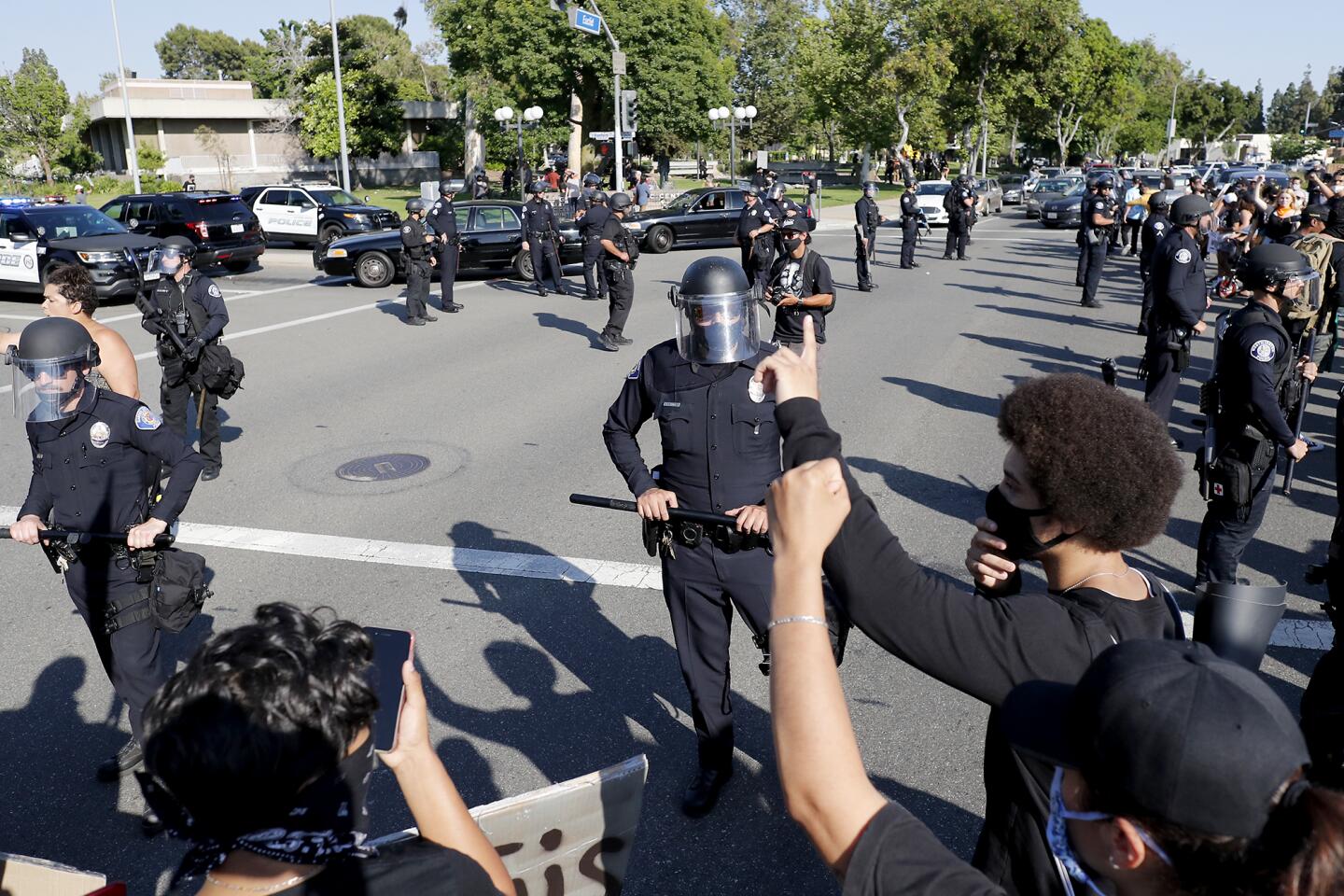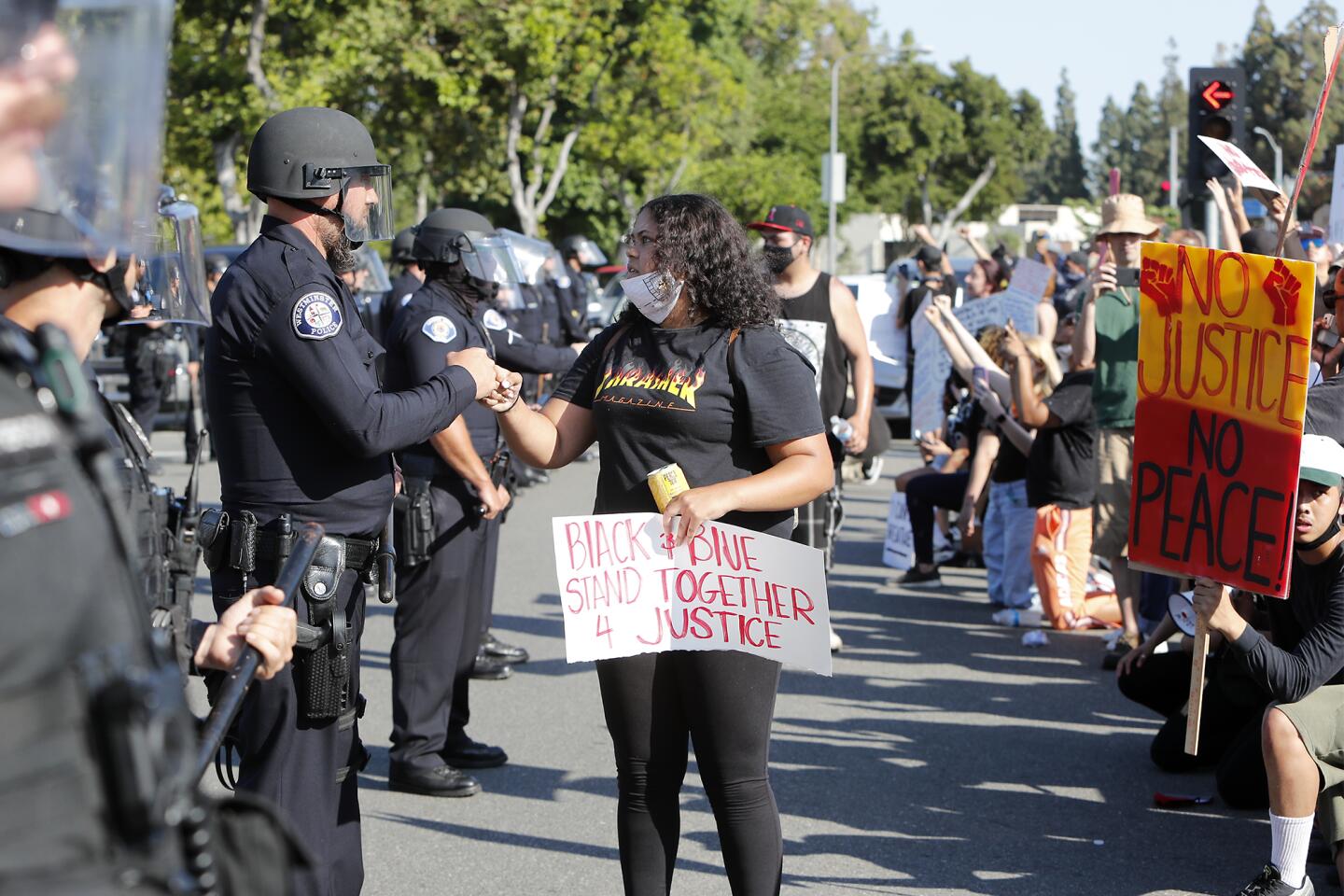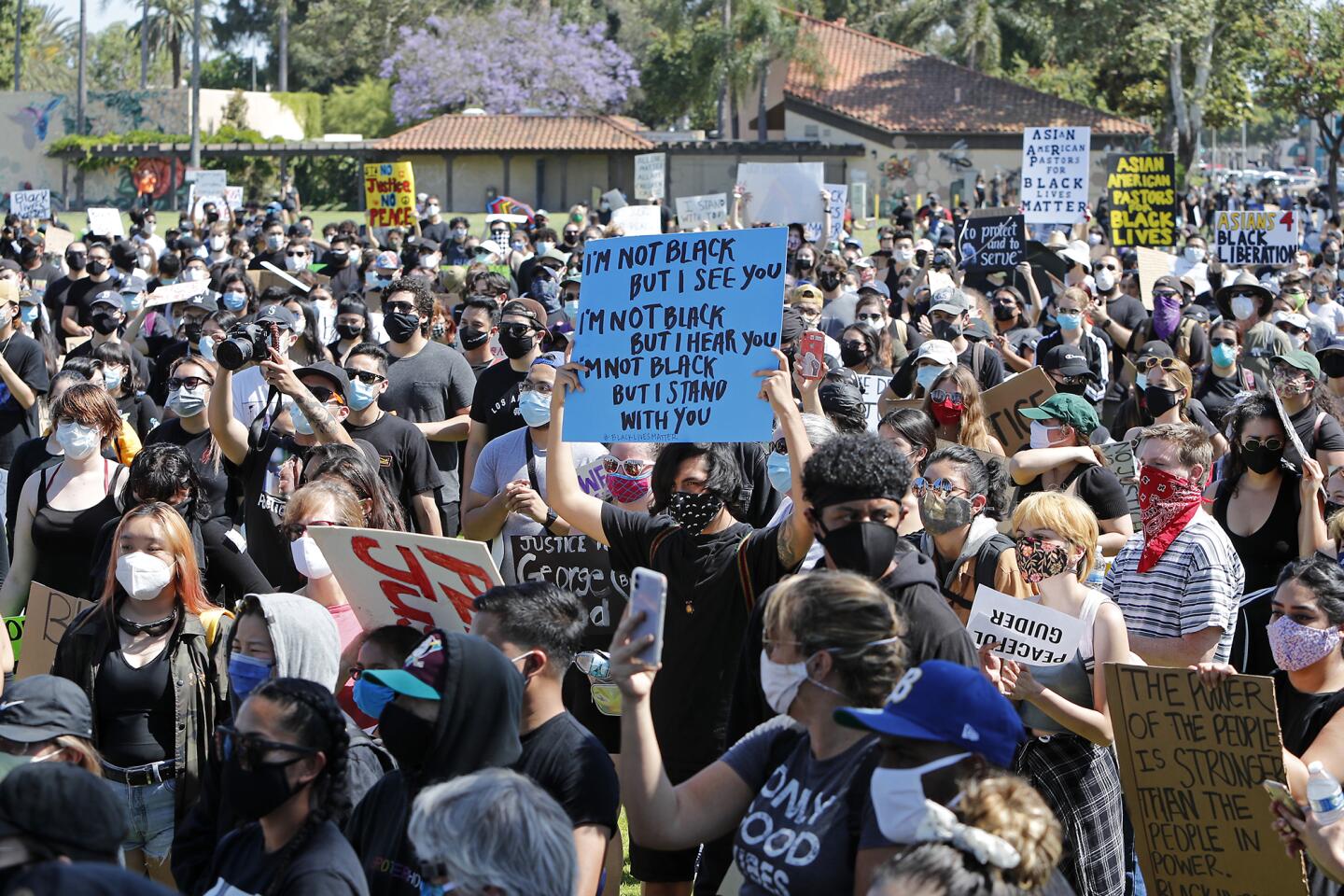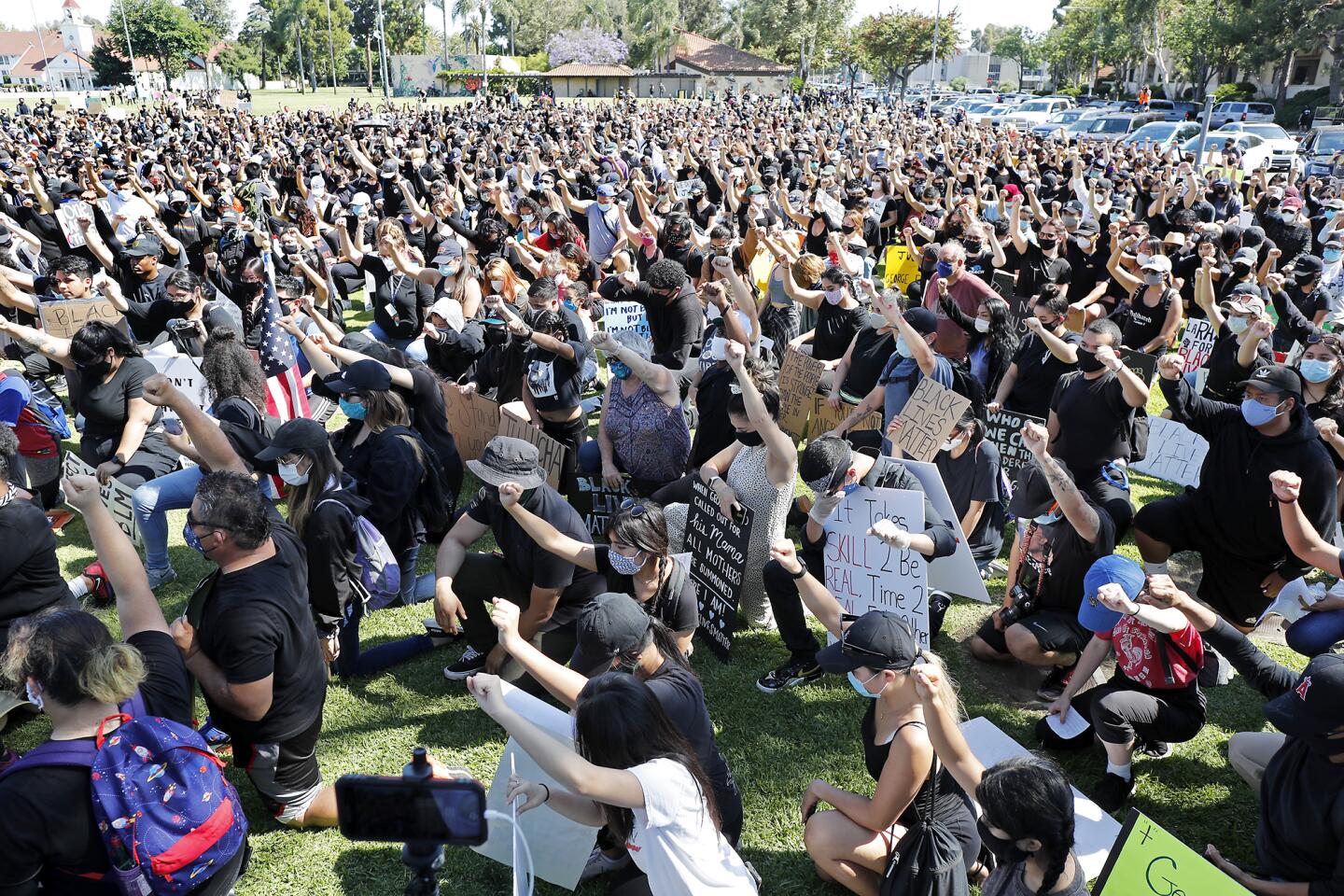O.C. teenagers organize a peaceful Black Lives Matter protest in Garden Grove that attracts thousands
Last August, local high school students came together to form the nonprofit organization MEEP Shows, an acronym for “More Empowering Events Please.”
The group of 12 is composed of youth from Garden Grove to Irvine to Long Beach. As people of color and those who identify as LGBTQ, they bonded over the racism and homophobia they encountered growing up in Orange County.
In November, they hosted their first event, an Abolish ICE music festival, and raised $4,000 for Border Kindness, a humanitarian aid organization that helps asylum seekers and refugees.
Less than a year later, in the aftermath of the unjust death of George Floyd at the hand of Minneapolis police, they hosted a protest in Santa Ana on Sunday that attracted hundreds, and a second one in Garden Grove on Wednesday that the Garden Grove Police Department estimates attracted between 3,000 to 4,000 people.
“There was so much misinformation going around,” said Meep’s Nicole Nguyen, referring to the rumors prior to the event that the protests were being planned by a terrorist organization.
Nguyen will graduate from Garden Grove High School next week. So will Heavyn Agu, her classmate who is the president of the school’s Black Student Union, that Meep asked to help lead Wednesday’s march.
They’re local teenagers who understand that Garden Grove, the fifth largest city in O.C., is diverse (40% white, 40% Asian, 39% Latino and 1% black) and politically divided (approximately 37% registered Democrats and 30% Republicans). As protests spread across then nation, they still saw “Blue Lives Matters” banners, countering the Black Lives Matter movement, hanging on buildings around their city.
They learned from the Santa Ana protest, Nguyen explained, where there were clashes with police before curfew approached, so they moved their original 4 p.m. start time to 3:30 p.m. and put out a notice on social media encouraging protesters to leave by 5:30 p.m. to avoid the 6 p.m. curfew.
As the protest began, Agu told the crowd that if anyone had plans to bring violence or loot local businesses, they should leave.
“That is not our message,” she said. “That’s not the way that we’re trying to get our point across.”
Lt. Carl Whitney of the Garden Grove Police Department confirmed there were no arrests or injuries reported and explained that the call for the crowd to disperse as the curfew approached was because cars were getting stuck at intersections. He said the organizers did a good job with their peaceful protest, and he appreciated that they cleaned up all the trash after the protest was over.
The Garden Grove Black Lives Matter protest began at the Village Green Park in front of the iconic “Tower on the Green” clock tower. Agu practiced the chants with the crowd, before protesters did a 4-mile loop down Euclid Street, Garden Grove Boulevard, Brookhurst Street and Chapman Avenue.
Yogi Mapaderun is a Nigerian American from New York, who moved to Garden Grove about a year ago to be closer to his family.
“I’ll never forget when I got arrested at 9 years old in front of my mom’s because I had a toy gun in my pocket,” he said. “No [expletive]. So I’m here for George Floyd, because of what they did to him. It’s [expletive]-ed up, man. How’re you gonna let that man die right in front of your face? Y’all didn’t hear that man scream more than seven times? ‘I can’t breathe.’”
Mapaderun’s stepbrother Mehr Khaliq, who is half black, is from Garden Grove.
“Growing up here, it’s been a lot of subtle things from everywhere around me,” said Khaliq, who is studying at Cal State Fullerton. “Most people are still subconsciously racist. They have things in the back of their mind, where, like, they’ll follow you around a store. There’s just certain small things that they do and how they react.”
This is his second protest. He went to the Anaheim protest on Monday.
“You see name after name after name [of black people killed by police] every week and sometimes you just get numb to it,” he said. “But this was just so in-my-face, and it felt like it was everyone who was involved, not just Black Lives Matter [activists] … It’s not ‘All lives matter’ until black lives matter. When people say ‘All lives matter,’ it’s disrespectful.”
It was Bernnuel Diaz’s fourth protest this week, after attending others in Los Angeles, Santa Ana and Anaheim.
Diaz grew up in Santa Ana and lives in Westminster, and he came with his friend Tecuani Tlalli from Anaheim to represent the O.C. chapter of the National Brown Berets.
The group, started in the 1960s, was formed to protest against social injustice against the Chicano community.
“I’m here to stand in solidarity with my African brothers and sisters against police brutality,” Diaz said.
Catherine Ji, an elementary school teacher from Irvine, dropped off her teenage daughter with her mother, who lives in Garden Grove and is recovering from hip surgery, before coming to the protest. She previously went to the one in San Clemente over the weekend.
She took a break from the walking to stand on the side and chant “Say his name,” as the crowd responded “George Floyd.”
“I am so sick and tired of seeing on social media the brutality and the violent deaths that take place against the black community,” she said. “I’m tired of the systematic and intrinsic oppression and inequality. I want this to stop, and I’m so glad to see the young people out there.”
Everyone out there at the protest in the midst of a pandemic is putting themselves at risk, she said.
“But this issue is too critical and important to the future of America that we can’t be locked up in our homes anymore,” she said. “Complacency is not acceptable anymore. We have to actively and willfully change the system.”
She carried a sign that said “Korean Americans for Black Lives.”
“As a Korean American, I wanted to be out here, because historically, there has been misguided animus between our communities,” she said, referring to the tensions between the Korean American and black communities during the 1992 L.A. riots.
As the protesters walked nearby Garden Grove’s Koreatown, she pointed out that many of the elders that run the local mom-and-pop shops there lost their businesses during the riots and moved to Orange County afterward.
Bryan H. Kim remembered the hamburger shop his father owned during the time of the riots. He said he’s proud his father’s black and Latino neighbors helped him protect his restaurant so it wasn’t physically destroyed. Yet, the store never financially recovered.
Kim is a pastor who co-founded the Ekko Church in Fullerton, and he came to the protest with his fellow pastors and church members carrying signs that said “Asian American Pastors for Black Lives.”
“The history of the churches in America is that they have often been too silent, especially during the Civil Rights era,” Kim said. “A lot of churches and a lot of Christians kept their mouths shut … But we’re a new generation of Christians, and we’re saying the Lord is out here. We believe Jesus would have been out here. And also as Asians, we have often been too silent. So we want to make sure the black community understands that we stand with our brothers and sisters.”
He said it was encouraging to see so many people out, but at the same time, he felt embarrassed as an American that these incidents of police brutality against the black community keep happening.
“We’re praying,” he said. “And we believe protest is a form of prayer.”
When the crowd returned to the clock tower, the organizers asked everyone to get down on the ground for a moment of silence lasting 8 minutes and 46 seconds, the amount of time that Derek Chauvin had his knee on George Floyd’s neck before he died.
Many lied down flat on their stomachs, with their hands behind them as if handcuffed.
And about half an hour after curfew, the crowd had dispersed peacefully.
The morning after, Agu felt sore from walking and her throat hurt from screaming into the megaphone during the protest. But she was happy.
Nguyen said she’s getting requests from other organizations that felt they set a good example for a peaceful protest and want to learn from MEEP.
She said it was important people know that while it’s great to come out for a protest, it’s even more important to translate that energy into direct action, whether it involves voting locally, signing petitions, donating or attending city council meetings.
“Change is not going to happen overnight,” Agu said, pointing to a quote she saw online: “Black lives matter even when it’s not a trend.”
“I hope everyone continues for days and months and years to come to spread awareness and fight for change.”
All the latest on Orange County from Orange County.
Get our free TimesOC newsletter.
You may occasionally receive promotional content from the Daily Pilot.
